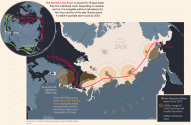In the USSR, this effect became known in the early sixties. A radar crew on the shore discovered that our own submarine, which was being tracked by radar for training purposes, remained visible on the radar screen even after diving - the radar simply "tracked" not the submarine itself, but its "trace" on the surface.
At the turn of the 1980s and early 1990s, the Pacific Fleet flew a Be-12 anti-submarine aircraft, specially modified for radar detection of one of the anomalies known to domestic specialists at the time. The results were positive - specially trained navigators were able to recognize the trace of a submerged submarine in the radar "picture". In fact, the aircraft crew now simply saw the place under which the submarine was located at depth.
The US was actively monitoring these works in Russia and was intensively conducting them themselves. They made a decisive step – they connected a specially configured aircraft radar (which we also had) with a powerful computing complex capable of accurately distinguishing that very anomaly from a similar, natural one. And the computers coped. Today, any American or Japanese anti-submarine aircraft “sees” the place under which a submarine is moving at depth. From a very large distance.
For the Russian submarine fleet, the outcome was disappointing. Here is what Lieutenant General of the Russian Navy's Naval Aviation V.N. Sokerin wrote about the Northern Fleet (NF) exercises:
"There was one smart officer serving in the command of the 57th Scud (Severomorsk-3) (57th mixed naval aviation division, now a disbanded unit of the Northern Fleet naval aviation – Vzglyad note)
. About a month after another assembly-cruise of the Northern Fleet ships, he... suggested looking at his analysis... He did a huge job, analyzed the movement patterns of all our boats that took part in the assembly-cruise, the "wiring" by air defense systems of all foreign aircraft in the area of operation of the fleet forces...
On the first and third days of the forces' presence at sea, one Orion (a patrol/anti-submarine aircraft of American manufacture - VZGLYAD note) flew in from AS Annenes
, flew along some "broken" route, and then went back. That smart officer, having "superimposed" on the map of the Orion's route the tracings of their actual location during the Orion's flight received from the submarine, made an unambiguous conclusion that... all ten "turning" points of its actual route were located absolutely precisely above the actual location (at the time of flight) of all 10 (!) submarines . "
This was back in the nineties. Today, all American and all Japanese anti-submarine aircraft have radars with mapping functions. The question is – why is this needed over the sea, what is there to map? Water?
And the answer is this - to get a clear radar picture from the surface of the water, you need exactly this precise radar, and it is there. And you also need a very powerful computing complex, and such a complex is also there.
What do anti-submarine drones from ships have to do with this? Given that their supposed prototype MQ-8B also received a radar with such a function. And they also have an optical-electronic surveillance system. This means that such a device can also carry a thermal imager suitable for detecting the emerging wake of a submarine. And buoys for identifying the detected underwater target, too. And the computing complex can be on the ship. Together with buoys, low-frequency illumination from ships, anti-submarine helicopters and torpedo weapons, future American anti-submarine drones will strengthen the already enormous anti-submarine capabilities of the US Navy and, possibly, its allies.

